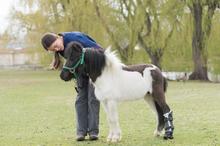Shine the miniature horse will trot into an exclusive club of Colorado equines with artificial hooves when he leaves the James L. Voss Veterinary Teaching Hospital this week.

Miniature horse Shine with new prosthetic leg
After suffering a vicious dog attack that mangled a hoof and led to infection, Shine needed surgical amputation of his lower-left hind leg in order to survive.
© 2016 by CSU-William Cotton
After suffering a vicious dog attack that mangled a hoof and led to infection, Shine needed surgical amputation of his lower-left hind leg in order to survive. His owners, Jacque Corsentino and Lee Vigil, asked veterinarians at Colorado State University to âdo whatever it takesâ to give the 3-year-old horse a chance at a normal life on their ranch in Florence, Colo.
In mid-March, Dr. Laurie Goodrich, an associate professor of equine orthopaedics, led a two-hour surgery to remove Shineâs infected hoof and distal limb below the fetlock, the hinge joint of the lower leg. She placed two stainless steel pins through the cannon bone to help support Shineâs leg while the wound healed.
Goodrich then used measurements from her patientâs radiographs and a 3-D printer to build an exact replica of his hoof, which helped Shine stay balanced while he healed.
Small size makes prosthesis possible
Shine has spent the past month at CSUâs Veterinary Teaching Hospital charming veterinary students while recuperating in a stall alongside full-sized horses that seem like giants next to the 30-inch-high, 150-pound mini.
Full-sized horses weigh between 800 and 2,000 pounds, typically making it impossible to outfit a severely injured horse with an artificial limb that will successfully carry the load. Horses in Shineâs condition â with broken bones and dangerous infections â are usually euthanized when treatment fails.
But his small size made Shine a good candidate for amputation and prosthesis. Itâs an uncommon approach, even for Goodrich, a practicing veterinarian for 25 years.
âItâs the first one Iâve done, but Iâve always wanted to try,â said Goodrich, who specializes in equine orthopaedic surgery. âWe had no way of preserving that limb. So we had to take it off, and this was the only option to preserve his life.â
The last CSU equine case involving amputation surgery and prosthesis occurred in 1998. Thatâs when Dr. Gayle Trotter performed surgery on a burro named Primrose, whose likeness is reflected in a bronze sculpture outside the hospital.
Shineâs journey begins after attack
Shineâs medical journey began at 6 a.m. Dec. 29, 2015. Corsentino went out to feed Shine and her two other miniature horses.
âHe didnât meet me at the gate like he always does, and he was standing funny,â Corsentino recalled. âI shined the flashlight on him, and he was covered in blood.â
Shine had puncture wounds on his face, a torn lip, a gashed knee, and he was bleeding from his left rear fetlock. Corsentino thinks he was attacked by dogs.
She treated Shine for two months with veterinary guidance, then sought another opinion from Dr. Britt Stubblefield, a CSU alumnus who owns Rocky Top Veterinary Service in southern Colorado. Radiographs revealed fractures in Shineâs coffin bone and lower pastern bone, the small but critical bones extending from the lower leg into the hoof.
âDr. Stubblefield called Dr. Goodrich from my barn, and then at least we knew we had some options, other than sending him to heaven,â Corsentino said. They made the four-hour trip to Fort Collins, and Goodrich quickly determined that the hoof had to be amputated.
One month after the surgery, Shine was fitted with an artificial hoof from OrthoPets, a company in Westminster, Colo., that specializes in animal prostheses. Founder Martin Kaufmann has worked with CSU on other cases, including that of Brutus, the famed Rottweiler with four prosthetic paws. Shine will be the fourth miniature horse to receive an OrthoPets hoof, which looks like a narrow ski boot with a foam liner and bike-tire treads.
As students and residents watched Shine take his first steps on his new hoof, fourth-year veterinary student Jessica Carie marveled at the difference. âI think this is awesome. Heâs already so much more comfortable than with the cast,â she observed.
Dr. Ellison Aldrich, the resident who has overseen Shineâs case, says the horseâs small size and personality have a lot to do with his recovery.
âHeâs very sweet, laid-back, easy to deal with,â she said. With so much recovery time at the equine hospital, his caregivers have gotten to know Shineâs tastes. âHis favorite food is Gobstoppers. Heâs so cute and people love to feed them to him. But he also loves apples and carrots.â
A new future with a new hoof
Corsentino had planned to train Shine as a show horse, but now is contemplating a different future for her little buddy. The family has set up a crowdfunding page through PetChance.org to help with Shineâs medical expenses.
âHeâs so comforting. You know when you have horrible days? Shine is my therapy,â Corsentino said. âI think he would make an amazing therapy horse for wounded warriors or kids with disabilities.â
Shineâs ordeal has deepened Corsentinoâs faith, and she hopes sharing his story will help to educate and inspire others. âEvery day I prayed and pleaded and cried out to God for a miracle,â Corsentino said. âNow thanks to the amazing team at CSU we can share his testimony. We have been blessed beyond words to work with such phenomenal doctors and support staff at CSU.â
Article by Kristen Browning-Blas
